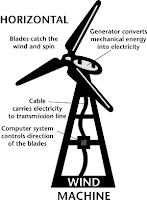 Wind energy gets a lot of bad press for its potential to injure and kill birds.
Wind energy gets a lot of bad press for its potential to injure and kill birds.On Kaua'i, particularly, where endangered Newell's shearwaters fly low from mountain nesting sites to the sea, there seems to be a fairly widespread assumption that wind is just too risky a proposition.
But what are the risks of other power sources, and how do they compare?
(Image: wind machine. Credit U.S. Energy Information Administration)
In New York State, an extensive study found that for all the danger to wildlife of those whirling blades, other forms of energy were considerably worse.
The New York State Energy Research and Development Authority produced a report on its study, entitled “Comparison of reported effects and risks to vertebrate wildlife from six electricity generation types in the New York/New England region.” A summary is available here.
A lot of the information isn't directly applicable to the Islands, of course, but it's an instructive study in terms of challenging common assumptions.
The first fact, of course, is that EVERY form of energy production has impacts on the natural environment. And with the exception of photovoltaic power, all have these things in common, the report says: “a turbine must be turned to drive a shaft in a generator. The generator produces electricity by spinning copper coils, or armature, through a magnetic field. A source of energy is needed to turn the turbine.”
The study looks at the impacts of oil, coal, natural gas, nuclear, hydro and wind. All but the middle two play a role in the Hawai'i power grids.
Ultimately, wildlife are arguably equally impacted by the power lines that birds like Newell's shearwaters run into, no matter what source produced the power.
With wind and hydro, once built, the wildlife risks appear entirely associated directly with their operations—streamlife impacted by the removal of water from rivers or being killed in the hydro plant mechanism. With wind, the risk of being struck by the blades.
With oil and coal, once the plants are built, there are toxic compounds released in their exhaust plumes, which promote such things as mercury accumulation in marine organisms, including edible fish, as well as ocean acidification and global warming.
These power plants are also tied to a permanent requirement that fuel be supplied, and all the attending risks associated with extraction and transportation.
This is not just a theoretical risk. In the Aug. 24, 1998, Tesoro oil spill on O'ahu, which drifted to Kaua'i. Hundreds of seabirds of different kinds were oiled, and many died. Some estimates suggested thousands or tens of thousands of seabirds may have been impacted.
The New York report concludes that wind has significant impacts in operation, notably, “high risks of bird and bat collisions with wind turbines during operation.” But when you look at the whole picture, that's not the most significant impact on wildlife, it says.
“Overall, non-renewable electricity generation sources, such as coal and oil, pose higher risks to wildlife than renewable electricity generation sources, such as hydro and wind.”
It may also be that wind energy has more potential for mitigation of wildlife impacts than other forms of power.
An example: Using a windpower firm's money to fence dogs out of a shearwater colony may save more shearwaters in a single season than a windmill will kill in its useful life.
In the case of the massive Kaheawa windfarm on Maui, the firm's website describes the goal of its habitat conservation plan:
“Identify the species likely to be affected and provide an estimate of the anticipated take for each; prescribe mitigation that will provide a net benefit to the species affected.”
And that, ultimately, may be a lot easier and less risky than mitigating the impacts the fossil fuel alternative.
© Jan TenBruggencate 2009
No comments:
Post a Comment